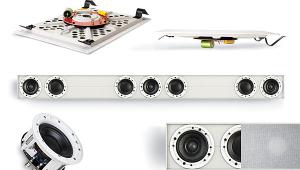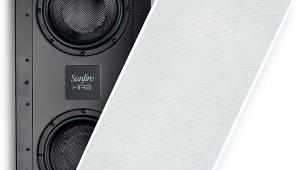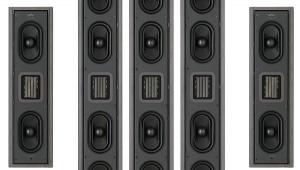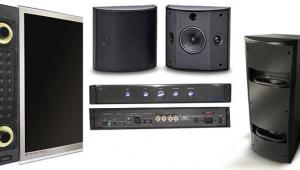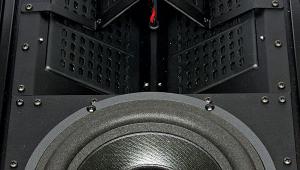An in-wall speaker system is a great way to enhance home audio without sacrificing space or aesthetics. These systems are designed to be installed within the walls, providing a clean and seamless look while delivering high-quality sound. Whether for a home theater setup or a multi-room audio system, the speakers can be discreetly integrated into your living space. If you're considering installing an in-wall speaker system during a renovation, professionals like those at www.chathampainters.net can help ensure that the installation is done efficiently and with minimal disruption to your home's interior.
Triad DS500 In-Wall Speaker System Page 3
Do They Sound Invisible?
The DS500 has the invisibility thing down. But what about the other, equally important aspect of a speaker—the way it sounds? Well, first of all, the DS500 isn’t designed to produce low-bass frequencies, so Triad emphasizes that you must use the included 120-hertz high-pass filter with the speakers. Of course, when you cross over the speakers this high, you’ll need a sub. You’ll also have to ask your subwoofer to play higher frequencies than it would with most other speakers. As a result, it’s easier to pinpoint the source of the bass frequencies in the room. Ideally, you should install or place the subwoofer along the wall centered as much as possible between the DS500s to optimize blending. But you should also place it where the low-frequency room interactions are acceptable. Triad sent an InWall SlimSub/4 with an outboard RackAmp 300 DSP 300-watt sub amplifier for me to use with the DS500s. The InWall SlimSub/4 is a unique sub that’s only 4 inches deep, so it’ll mount in a standard wall. This should make it easier to find an optimal mounting location, but it has a typical grille and isn’t invisible when it’s installed.

I’ve already mentioned that the DesignerSeries speakers have an interesting dispersion pattern. As Scarpelli informed me, conventional speakers drop off in level faster with distance than these do. Since they have extremely diffuse dispersion, this prevents them from hotspotting. These qualities make them ideal to use for background music or surround speakers. I could also place the speakers far apart and still have an enjoyable, believable stereo listening experience.
Considering that the speakers (but not the sub) are totally concealed, the DS500s and InWall SlimSub/4 sound remarkable. Because of the DS500’s distributed mode nature and since it mounts flush with the wall, the sound has an ethereal quality that’s hard to describe. I took some not-so-controlled in-room measurements with an SPL meter and a test disc. These suggested that the unequalized speaker output dropped off dramatically above 9,000 Hz. This made the speakers sound a bit soft and distant.
Still, for some reason, perhaps because there were no speakers to draw attention and provide a reference point, it wasn’t objectionable. My second in-room measurement suggested that my Onkyo AVR’s built-in Audyssey processing extended the rolloff to some point above 16,000 Hz. This improved things dramatically. Thankfully, the speakers also retained the airy character that made the reproduced audio sound as if it were simply floating in the air. I also achieved similar results with the AVR’s limited user EQ. (I wish I’d had—and would recommend—a more elaborate EQ to better compensate.)
 Would I recommend these speakers for critical two-channel or high-end home theater use? No, but they’ll work really well for just about any other situation where you don’t want a floorstanding speaker or a traditional in-wall. For example, my Definitive Technology Mythos Four speakers provided a much more pinpoint, in-your-face playback of Lady Gaga’s The Fame Monster CD (I only play it for professional reasons). The DS500s played back much of the same energy, but the experience was like I had stepped back from the music a foot or two. Interestingly, detail and depth were still there. (The four separate a cappella voices in Anonymous 4 Love’s Illusion CD were distinctly present, along with the overtones and echoes at a lower level.) I’d almost liken it to what happens with certain speakers when you compare the sound with the grille on and off. But in this case, it’s less a masking of detail as it is a reduction in output. With that said, what the DS500 lacks in immediacy, it makes up for in ethereality.
Would I recommend these speakers for critical two-channel or high-end home theater use? No, but they’ll work really well for just about any other situation where you don’t want a floorstanding speaker or a traditional in-wall. For example, my Definitive Technology Mythos Four speakers provided a much more pinpoint, in-your-face playback of Lady Gaga’s The Fame Monster CD (I only play it for professional reasons). The DS500s played back much of the same energy, but the experience was like I had stepped back from the music a foot or two. Interestingly, detail and depth were still there. (The four separate a cappella voices in Anonymous 4 Love’s Illusion CD were distinctly present, along with the overtones and echoes at a lower level.) I’d almost liken it to what happens with certain speakers when you compare the sound with the grille on and off. But in this case, it’s less a masking of detail as it is a reduction in output. With that said, what the DS500 lacks in immediacy, it makes up for in ethereality.
My latest favorite band, Ha Ha Tonka, from the Ozarks (insert your favorite snide comment here), also sings an a cappella tune in four-part harmony on their Buckle in the Bible Belt disc. The song, called “Hangman,” is a bit more haunting, as it concerns a guy who’s ready to hang “from the gallow’s pole.” As with Anonymous 4, the voices sounded clear and distinct, but the song is even more eerie because of the way the sound hangs in the air.
Would You Rather…?
Since Triad didn’t send five DS500s (the scoundrels), I couldn’t set up an invisible in-wall surround system. However, from their airy two-channel performance, I’d say the DS500s would make phenomenal surround-channel speakers. They could rival any other in-walls for movies (although not necessarily DVD-Audio). I can’t say that Triad’s DS500 in-wall speakers are the best-sounding in-walls I’ve ever heard, because they’re not. But they don’t sound like crap, either. In fact, they sound pretty darn good. Of course, if sound quality is your ultimate goal, “pretty darn good” is a euphemism you don’t want to hear. But then again, if sound quality is your ultimate goal, you should consider visibility a given anyway.
All speakers involve compromises of some sort, from the design stage all the way to where you place them in your listening room. For $2,100 per pair, you can get some absolutely stinking-good freestanding or in-wall speakers. In some respects, they’ll likely sound better than the DS500s. But they won’t look better—and they’ll either take up real estate on your floor or be an eyesore on your wall. Some folks can live with that. Others can’t. If you want invisibility, you’ll have to pay a price. Fortunately, Triad’s DesignerSeries in-walls start at $500 each. The main difference is overall decibel output capability (small room = lower output = lower cost). For background music, these things are killer. In fact, for most of the rooms in most people’s homes, the DS500s (or the less powerful versions) would likely be fantastic. Because of the invisibility factor, they’ll even be killer for some people for each channel of a home theater. However, serious audiophiles probably shouldn’t apply here.
All in all, here’s what I have to say: I have yet to hear a better invisible in-wall speaker. (And I’ve heard many.) If you can afford it and you don’t want to see it, Triad’s DS500 is the one to buy. And that’s no euphemistic claim. It’s the unvarnished—if a bit plastered—truth.

- Log in or register to post comments




